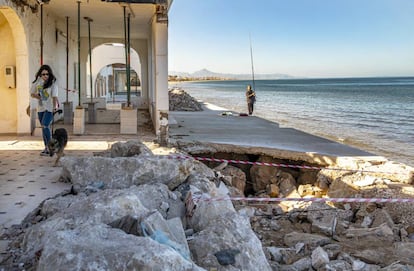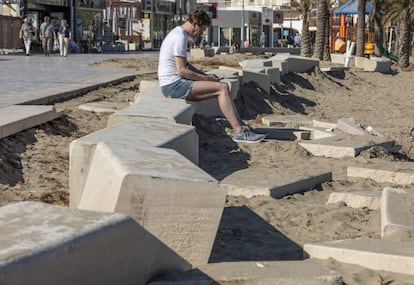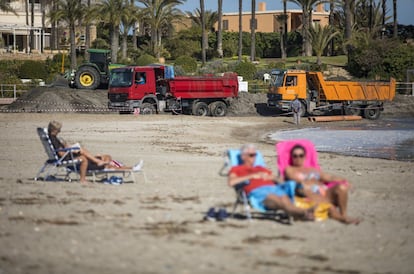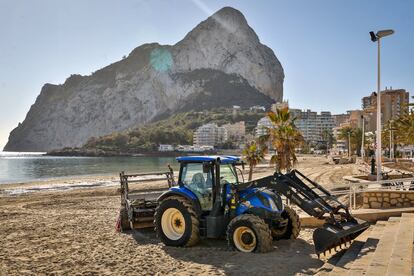Spanish beaches hit by Storm Gloria struggling to recover before vacations
Towns affected by last month’s extreme weather are rushing to clean up in time for the Easter break, as questions are raised about the sustainability of coastal management

“The sea takes back what belongs to it,” says Nuria in an almost reverential tone. She is standing in front of the cafe she works at as excavators struggle to remove the damage left on the beach and seaside promenade, which were flooded when Storm Gloria hit Spain’s Mediterranean region at the end of January.
“If this happens, it’s because it’s our fault. We are occupying [the sea’s] territory,” she says.

Nuria works in Calp, a coastal town in Alicante province in Spain’s eastern region of Valencia that was seriously damaged by Storm Gloria. Life in the town is returning to normal but the scars of the disaster can still be seen – and smelled, with the wind carrying the stench of rotting seaweed. Between January 20 and 25, Storm Gloria left 13 people dead and devastated more than 2,000 kilometers of coastline from Murcia region to Girona province in Catalonia, as well as the Balearic Islands. The storm caused more than €54 million in damage just to the beach and shoreline area, according to the first estimates from the Ministry for Ecological Transition.
What is needed are long-term solutions that are more respectful of natureJordi, retired lawyer
It was a historic storm. Beaches were swallowed up, losing up to 35 meters, while eight-meter waves battered seafront houses, smashed concrete sidewalks and flooded stores. The sea dragged away millions of tons of sand, left thousands of fish to die on the shore and spat out all manner of filth, including plastic ice cream containers that were manufactured 40 years ago.
A tour of the beaches worst hit by the storm gives a sense of the magnitude of the catastrophe, and the determination of the towns, particularly those most popular with tourists, to bounce back in time for the Easter vacation break in April. But at the same time, there are calls for change, with many arguing that it is not rational to keep rebuilding and using a space that is increasingly under threat by extreme weather conditions.
New mentality needed
The lights of a few outdoor restaurants can now be seen on the seaside promenade of Xàbia, a coastal town in the province of Alicante. At Arenal Beach, a group of tourists sunbathes between the excavators and concrete pylons that were dragged away by the storm. “If 80% of GDP here comes from tourism, how could we not fix the beach and the promenade? But what is needed are long-term solutions that are more respectful of nature because climate change is hitting at full force,” says Jordi, a retired lawyer specializing in international law.

Mario, the owner of La Bodeguita Bar, agrees: “What I am saying might not be very popular among restaurant owners, but we have to be more sustainable, change our mentality and not go against nature.” He uses La Marineta beach in the coastal city of Dénia as an example. At La Marineta beach, seaweed tends to build up and is not removed, despite complaints to the local council. During Storm Gloria, this created a natural barrier and prevented the nearby buildings from being more seriously damaged.
In the Valencian municipality of Bellreguard, the remains of the seaside promenade lie in large blocks along the beach. But the mayor of Bellreguard, Àlex Ruiz of the leftist Compromís party, has raised questions about how it should be restored. In a message on Facebook, Ruiz asked “if it was worth spending money we don’t have” on rebuilding a promenade in the same way, given that it could end up smashed to pieces in the next storm.
In recent days, engineers, environmentalists, politicians, local residents and even tourists have come up with numerous proposals on how to combat storms and protect Spain’s beaches. These include placing breakwaters or rock barriers to dissipate the force of the sea, building sand dunes on the beach to act as embankments, and using soft and natural materials for the seaside promenades.
Hugo Morán, the Secretary of State for the Environment, says that “we have to rethink the way of managing the coast” given the effects of climate change. “To protect the coast we are going for solutions based on nature and on engineering, when these are needed. But there is not one right answer to everything. We are working on strategies for every case,” he tells EL PAÍS.
“There is no beach here”
The village of L’Ampolla in Tarragona province sits at the gateway to the Ebro River Delta, where Storm Gloria pushed waves as far as three kilometers inland. Today the village’s Arenal Beach is almost non-existent. “There is no beach here,” says Daniel, a chef at Beach Club Bama, which looks out onto the former beach. “Before a storm would come and the sea would go back but now look. All the beaches of the Delta are losing sand because the river no longer brings sediment when it comes down from the mountain.”

It’s a different case in Torredembarra, a small town in the province of Tarragona. Its seaside promenade was practically undamaged, despite not having a protection wall. “There is a natural, longitudinal barrier of rocks, which are submerged between 1.5 and two meters,” explains Mayor Eduard Rovira, from the Catalan Republican Left. “Many people asked us for a wall for the promenade so they wouldn’t have to constantly sweep away the sand, but it was made this way [in the middle of the 1990s] on purpose. The sand moves naturally and this means that when there is a large wave the sand is transported, which also protects houses.”
The big beaches of cities such as Valencia and Barcelona were also hit hard by Storm Gloria, as well as the smaller ones of Girona province in the northeastern region of Catalonia. Imma Colom, the mayor of Tossa de Mar, north of Barcelona, says there is “absolute uncertainty” about the future of the municipality’s beaches, some of which have disappeared, while others are in desperate need of sand.
Meanwhile in Santanyí, a village on the Balearic Island of Mallorca, the local council is rushing to recover in time for the holiday season after Storm Gloria swallowed up 13 beaches and left others covered in rocks and seaweed. “We have to be at 100% for the high season,” says Deputy Mayor Joan Gaspar. “We cannot allow ourselves to begin the season with the beaches like this with the quality of tourism we have.”
English version by Melissa Kitson.
Tu suscripción se está usando en otro dispositivo
¿Quieres añadir otro usuario a tu suscripción?
Si continúas leyendo en este dispositivo, no se podrá leer en el otro.
FlechaTu suscripción se está usando en otro dispositivo y solo puedes acceder a EL PAÍS desde un dispositivo a la vez.
Si quieres compartir tu cuenta, cambia tu suscripción a la modalidad Premium, así podrás añadir otro usuario. Cada uno accederá con su propia cuenta de email, lo que os permitirá personalizar vuestra experiencia en EL PAÍS.
¿Tienes una suscripción de empresa? Accede aquí para contratar más cuentas.
En el caso de no saber quién está usando tu cuenta, te recomendamos cambiar tu contraseña aquí.
Si decides continuar compartiendo tu cuenta, este mensaje se mostrará en tu dispositivo y en el de la otra persona que está usando tu cuenta de forma indefinida, afectando a tu experiencia de lectura. Puedes consultar aquí los términos y condiciones de la suscripción digital.
More information
Últimas noticias
Most viewed
- Alain Aspect, Nobel laureate in physics: ‘Einstein was so smart that he would have had to recognize quantum entanglement’
- David King, chemist: ‘There are scientists studying how to cool the planet; nobody should stop these experiments from happening’
- Maps of the US attack on Venezuela: Targets, airspace and deployed fleet
- Key points of the military attack on Venezuela: Early morning bombings and a ‘captured’ president
- World reactions to the US strikes on Venezuela











































